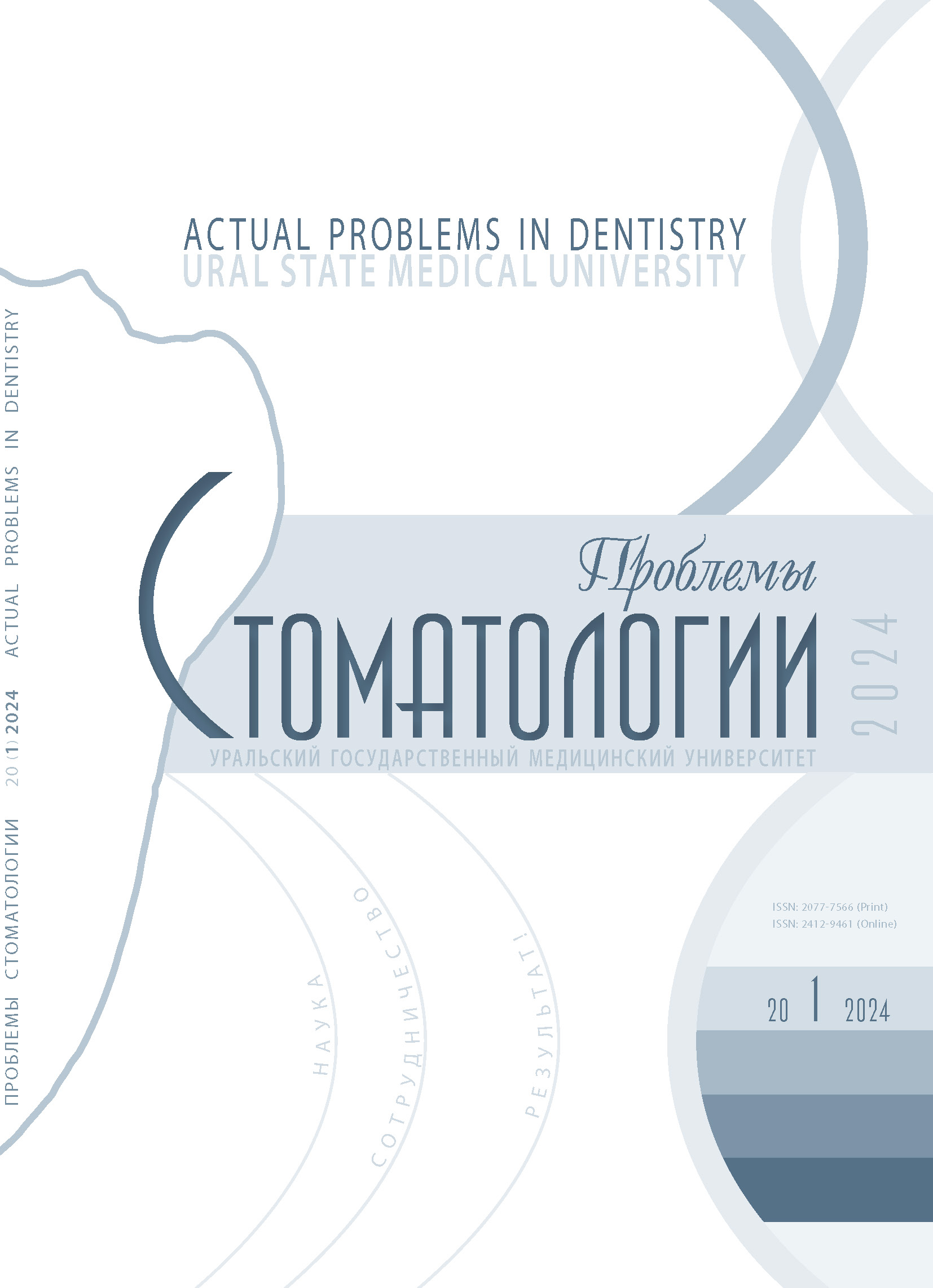Kazan, Kazan, Russian Federation
Chuvash State University named after I. N. Ulyanov (Department of Propaedeutics of Dental Diseases and New Technologies, Professor of Department)
Cheboksary, Cheboksary, Russian Federation
UDC 616.31
The literature provides information on the high prevalence of periodontal diseases and hard tooth tissues in patients in a psychiatric hospital. The relationship between periodontal microbiota and psychiatric pathology and the need to maintain oral health among this group of patients is discussed. The aim of the investigation was the study of the structure of periodontal diseases in patients of a psychiatric hospital, in various age groups. Material and methods of research. In the Republican Clinical Psychiatric Hospital named after V.N. Bekhterev (Kazan) in the period from 2014 to 2018, 200 patients (95 women and 105 men) aged 35 to 65 years (average age 56,26 ± 6,74) were examined. The questionnaire recorded the patient's age, sex, diagnosis of the underlying disease, dental formula, a standard periodontal diagram was filled in. The maximum depth of the periodontal pocket was determined by sequential measurements. The results of the study. In 100% of patients in a psychiatric hospital, periodontal tissue damage was detected, of which 86.5% in the form of chronic periodontitis. The maximum number of patients with periodontitis was detected in the age group of 51–60 years. The largest number of teeth removed in patients over 70 years of age. There was a direct strong correlation between age and the number of teeth removed (rp = 0.923; p < 0.001). The maximum depth of the periodontal pocket was also in the age group of 51–60 years and amounted to 4,25 ± 1,14 mm. A direct strong correlation of the depth of the periodontal pocket with the number of teeth removed was revealed. The deeper the patient has pathological pockets, the more teeth are removed (rp = 0.892). Conclusions. The results of the study suggest the need to develop training programs for patients and psychiatric hospital staff to improve the quality of life of patients and general health.
patients with psychiatric pathology, chronic periodontitis, tooth removal, dental status
1. Elizova L.A., Atrushkevich V.G., Orehova L.Yu. Novaya klassifikaciya zabolevaniy parodonta. Parodontit. Parodontologiya. 2021;26(1):80-82. [L.A. Elizova, V.G. Atrushkevich, L.Yu. Orekhova. New classification of periodontal diseases. Periodontitis. Periodontology. 2021;26(1):80-82. (In Russ.)]. https://www.parodont.ru/jour/article/view/433
2. Il'ina R.Yu., Muhamedzhanova L.R. Prichiny udaleniya zubov u pacientov psihiatricheskogo stacionara. Problemy stomatologii. 2023;19(3):69-74. [R.Yu. Il'ina, L.R. Muhamedzhanova. Reasons for tooth extraction in psychiatric hospital patients. Actual Problems in dentistry. 2023;19(3):69-74. (In Russ.)]. https://doi.org/10.18481/2077-7566-2023-19-3-69-74
3. Strel'nikova N.V., Antonova A.A., Turkutyukov V.B., Shapovalenko E.S. Epidemiologiya nespecificheskih parodontitov, vyzvannyh bakteriyami roda Leptotrichia, pri hronicheskom i recidiviruyuschem techenii infekcii. TMZh. 2018;4(74):34-39. [N.V. Strel'nikova, A.A. Antonova, V.B. Turkutyukov, E.S. Shapovalenko. Epidemiology of nonspecific periodontitis caused by bacteria of the genus Leptotrichia in chronic and recurrent infection. TMG. 2018;4(74):34-39. (In Russ.)]. https://cyberleninka.ru/article/n/epidemiologiya-nespetsificheskih-parodontitov-vyzvannyh-bakteriyami-roda-leptotrichia-pri-hronicheskom-i-retsidiviruyuschem.
4. Araújo MM, Martins CC, Costa LC, Cota LO, Faria RL, Cunha FA, et al.. Association between depression and periodontitis: a systematic review and meta-analysis. J Clin Periodontol. 2016; 43: 216–28. DOI: https://doi.org/10.1111/jcpe.12510
5. Bernabe E., Marcenes W., Hernandez C.R., Bailey J., Abreu L.G., Alipour V. et al. Global, regional, and national levels and trends in burden of oral conditions from 1990 to 2017: a systematic analysis for the global burden of disease 2017 study // J Dent Res. – 2020;99:362-373. DOI:https://doi.org/10.1177/0022034520908533.
6. Denis F., Millot I., Abello N., Carpentier M., Peteuil A., Soudry-Faure A. Study protocol: a cluster randomized controlled trial to assess the effectiveness of a therapeutic educational program in oral health for persons with schizophrenia // Int J Ment Health Syst. – 2016;5:10-65. DOI:https://doi.org/10.1186/s13033-016-0096-0.
7. DiGiulio D.B., Romero R., Amogan H.P. et al. Microbial prevalence, diversity and abundance in amniotic fluid during preterm labor: a molecular and culture-based investigation // PLoS One. – 2008;3(8):e3056. DOI:https://doi.org/10.1371/journal.pone.0003056.
8. Dominy S.S., Lynch C., Ermini F., Benedyk M., Marczyk A., Konradi A. et al. Porphyromonas gingivalis in Alzheimer's disease brains: evidence for disease causation and treatment with small-molecule inhibitors // Sci Adv. – 2019;5:23-44. DOI:https://doi.org/10.1126/sciadv.aau3333
9. Eltas A., Kartalcı S., Eltas S.D. et al. An assessment of periodontal health in patients with schizophrenia and taking antipsychotic medication // Int J Dent Hyg. – 2013;11:78-83. DOIhttps://doi.org/10.1111/j.1601-5037.2012.00558.x
10. Fluegge K. Correspondence: Periodontal Health among Non-Hospitalized Chronic Psychiatric Patients in Mangaluru City-India // J Clin Diagn Res. – 2017;11(1):83-31. DOI:https://doi.org/10.7860/JCDR/2017/24900.9208.
11. Liu F., Wen Y.F., Zhou Y., Lei G., Guo Q.Y., Dang Y.H. et al. A meta-analysis of emotional disorders as possible risk factors for chronic periodontitis // Medicine (Baltimore). – 2018;97:114-134. DOI:https://doi.org/10.1097/md.0000000000011434
12. Martínez M., Postolache T.T., García-Bueno B. et al. The role of the oral microbiota related to periodontal diseases in anxiety, mood and trauma- and stress-related disorders // Front Psychiatry. – 2021;12:81-41. DOI:https://doi.org/10.3389/fpsyt.2021.814177
13. Morales-Chávez M.C., Rueda-Delgado Y.M., Peña-Orozco D.A. Prevalence of bucco-dental pathologies in patients with psychiatric disorders // J Clin Exp Dent. – 2014;6(1):87-111. DOI:https://doi.org/10.4317/jced.51147.
14. Tang W.K., Sun F.C., Ungvari G.S., O'Donnell D. Oral health of psychiatric in-patients in Hong Kong // Int J Soc Psychiatry. – 2004;50(2):186-191. DOI:https://doi.org/10.1177/0020764004043134.
15. Tong S., Lyu Y., Huang W., Zeng R., Jiang R., Lian Q., Leung F.W., Sha W., Chen H. Genetically predicted causal associations between periodontitis and psychiatric disorders // BMJ Ment Health. – 2023;26(1):300-864. DOI:https://doi.org/10.1136/bmjment-2023-300864.
16. Torales J., Barrios I., González I. Oral and dental health issues in people with mental disorders // Medwave. – 2017;17(8):70-145. DOI:https://doi.org/10.5867/medwave.2017.08.7045.
17. Wey M.C., Loh S., Doss J.G., Abu Bakar A.K., Kisely S. The oral health of people with chronic schizophrenia: A neglected public health burden // Aust NZJ Psychiatry. – 2016;50(7):685-694. DOI:https://doi.org/10.1177/0004867415615947.
18. Zheng D.X., Kang X.N., Wang Y.X., Huang Y.N., Pang C.F., Chen Y.X. et al. Periodontal disease and emotional disorders: a meta-analysis // J Clin Periodontol. – 2021;48:180-204. DOI:https://doi.org/10.1111/jcpe.13395



















